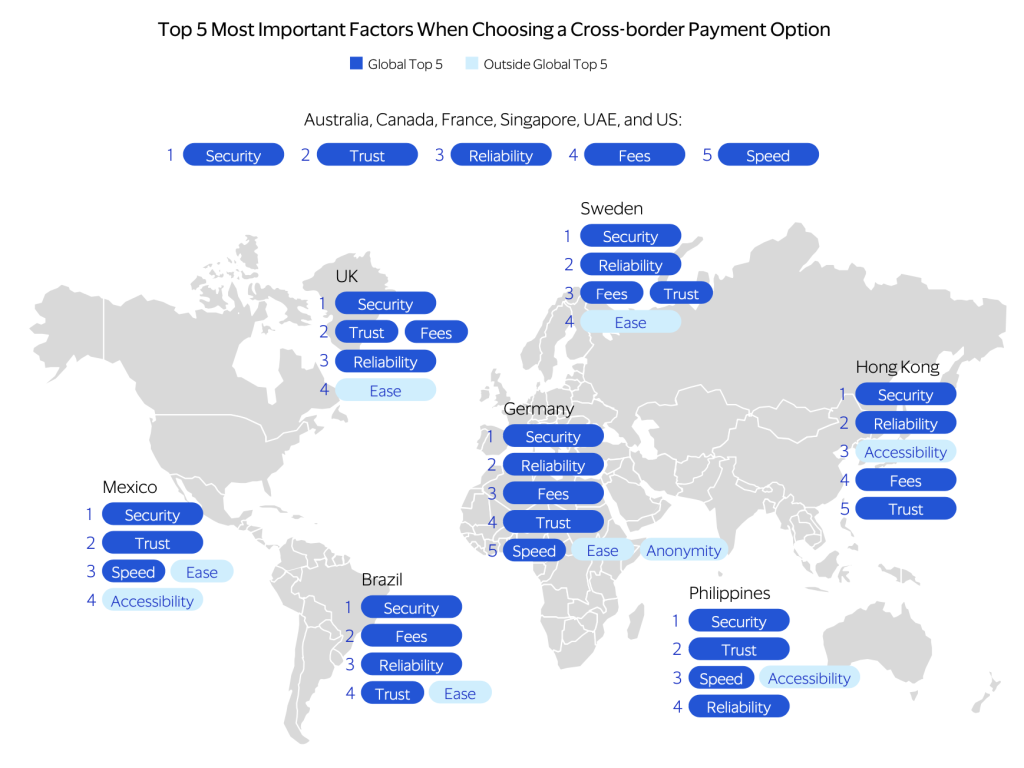Estimated reading time: 4 minutes
- Most consumers utilize various platforms for cross-border payments, according to a recent Visa report.
- Security remains a paramount concern in cross-border payments.
- Transparency regarding transaction costs and processing times is essential for enhancing customer trust.
A recent Visa report on consumer preferences in cross-border payments reveals a dynamic and expanding industry characterized by a diverse clientele that prioritizes security in their financial transactions. Despite the increasing number of cross-border payment providers, many users have yet to find a single reliable platform, opting instead to use multiple methods tailored to their specific requirements.
This scenario presents a significant opportunity for payment providers to engage with a growing and somewhat fragmented market, enabling them to establish themselves as the preferred choice for all cross-border payment needs.
An Expanding Industry
The Visa report surveyed 6,500 individuals who had conducted cross-border payments within the previous year to uncover insights into their habits, preferences, and trusted providers. It is projected that approximately $250 trillion will flow through cross-border payments by 2027, marking an increase of $100 trillion from 2017 figures. This immense volume underscores the integral role that cross-border payments play in the contemporary economy, impacting an astonishing 771 million users annually.
Cross-border payments facilitate various essential activities, including international travel, remittances, online commerce, and foreign investments. Notably, over half of the respondents reported traveling abroad multiple times each year, and 45% indicated that they send or receive remittances on a monthly basis, highlighting the significant demand for reliable and secure payment solutions.
The magnitude of cross-border payments is challenging to convey through statistics alone; many transactions involve relatively small sums that are nonetheless crucial for recipients. Approximately one-third of respondents reported making weekly cross-border payments, with this frequency increasing among younger demographics: 84% of Gen Z participants and 83% of Millennials reported engaging in cross-border transactions.
The Search for Providers
The considerable prevalence of cross-border payments, coupled with a burgeoning customer base, makes the lack of established providers particularly striking. While 66% of consumers expressed a desire for a single, dependable payment provider, only 16% had identified a default payment method they could consistently rely upon.
Currently, both the payment providers and methods employed vary depending on the type of transaction. Credit and debit cards are favored for e-commerce and travel-related payments, while bank transfers dominate the remittance space.
Though 20% of consumers expressed a desire for a broader array of options for transactions, many reported feeling overwhelmed by the choices available, particularly those focused on sending and receiving remittances. However, a notable trend has emerged: consumers are solidifying their preferences, with 66% indicating that they would remain loyal to a payment option that meets their needs. This suggests that convenience and trust are more important than variety, as half of the customers prefer to consolidate their finances with a single provider.
Changing Priorities
When prioritizing their needs in cross-border payments, consumers overwhelmingly value security above all else. Security emerged as the top concern for 61% of respondents, transcending considerations of convenience, affordability, or reliability.

This heightened focus on security is likely a response to the rising incidence of fraud, scams, and delays in cross-border payments, particularly among younger users like Gen Z. Alarmingly, 21% of customers reported experiencing negative issues when making cross-border payments.
Consumers are increasingly vigilant about fraud risks; over half of those surveyed admitted to halting a transaction due to concerns about potential fraud. This anxiety spans various payment methods, including credit card transactions and bank transfers, but is often more pronounced when using newer market entrants that may lack the established trust of traditional players.
To address these concerns, consumers expect payment providers to proactively implement safety measures. An impressive 88% of respondents indicated that they want financial institutions and fintechs to enhance security protocols. Simple initiatives, such as purchase confirmations, tracking mechanisms, and recipient verifications, can significantly bolster consumer confidence.
Moreover, to alleviate concerns about transaction delays and hidden fees—especially among those engaged in remittances—companies must prioritize transparency regarding processing times and transaction costs.
—
In conclusion, the Visa report underscores the immense potential within the cross-border payments sector. With transaction volumes on the rise and a young, diverse, and informed customer base actively searching for reliable providers, the industry stands at a pivotal moment. Cross-border payment providers, whether traditional or emerging, have a unique opportunity to establish themselves as the trusted choice, catering to a clientele whose priorities revolve around security, reliability, and a variety of options. The call to action is clear: payment providers must rise to the occasion and develop cross-border payment solutions that align with consumer expectations.




